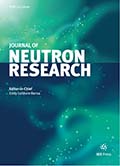Authors: Zimmer, Oliver | Bigault, Thierry | Degenkolb, Skyler | Herb, Christoph | Neulinger, Thomas | Rizzi, Nicola | Santoro, Valentina | Takibayev, Alan | Wagner, Richard | Zanini, Luca
Article Type:
Research Article
Abstract:
This paper discusses design principles and possible performances of an “in-beam” ultracold neutron (UCN) source for the European Spallation Source (ESS). The key components of the proposed neutron delivery system are nested-mirror optics (NMO), which image the bright neutron emission surface of the large liquid-deuterium moderator, studied within the HighNESS project, onto a remotely located superfluid-helium converter. Bandpass supermirrors, with optional polarization capability, enable the selective transport of those neutrons that are most effective for UCN production, exploiting the single-phonon conversion process that is possible for neutrons having wavelengths within a narrow range centered on 8.9 A ˚
…. NMO are capable of extracting and refocusing neutrons with small transport losses under the large solid angle available at the ESS Large Beam Port (LBP), allowing the converter to be placed far away from the high-radiation area in the ESS shielding bunker, where the source stays accessible for trouble-shooting while facilitating a low-background environment for nearby UCN experiments. Various configurations of the beam and converter are possible, including a large-volume converter – with or without a magnetic reflector – for a large total UCN production rate, or a beam focused onto a small converter for highest possible UCN density. The source performances estimated by first simulations of a baseline version presented in this paper, including a saturated UCN density on the order of 10 5 cm − 3 , motivate further study and the development of NMO beyond the first prototypes that have been recently investigated experimentally.
Show more
Keywords: Ultracold neutrons, UCN source, nested-mirror optics, NMO, European Spallation Source, ESS
DOI: 10.3233/JNR-220045
Citation: Journal of Neutron Research,
vol. 24, no. 2, pp. 95-110, 2022





